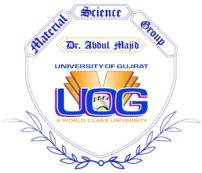Material Science Group's Newsletter-2019
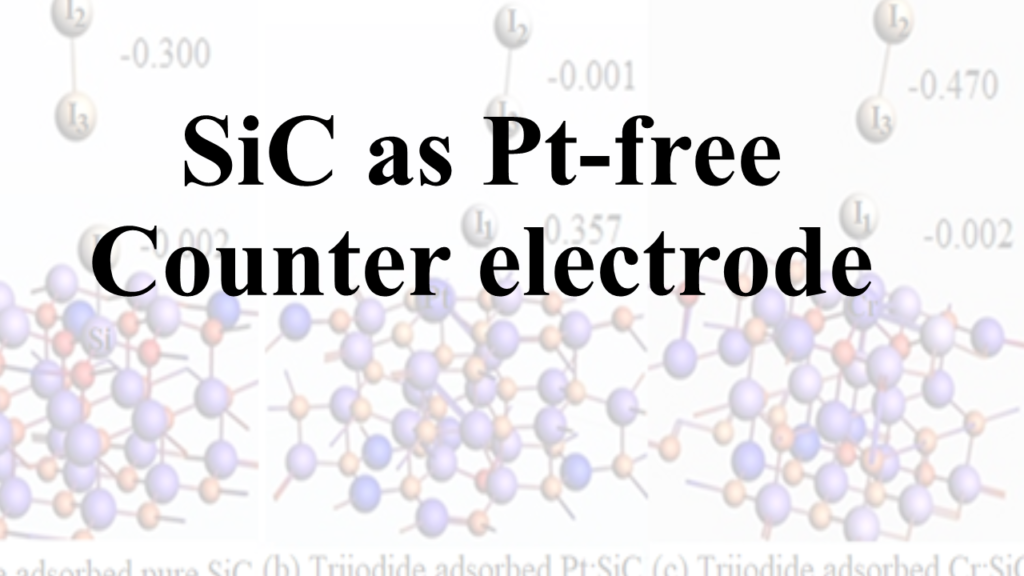
Editorial Board
Dr. Abdul Majid (Group Leader) (abdulmajid40@uog.edu.pk)
Ms. Amber Batool (Editor)
Letter from the Chair
Head of Material Science Group
The last decade has been exciting part of life due to active involvement in research as it given me a sense of contribution either to basics of Physics or to different applications. The research, either experimental or theoretical, is not only an indicator of hope for humanity but also strengthening the human supremacy on other creations of God. The experimentalists are practically producing realities whereas theoreticians are uncovering the scientific phenomenon through modeling, analysis and first principles methods. Having worked on top class experimental facilities as well as enjoying ab-initio quantum mechanical computations on world’s best equipment, then a luxury that cannot be afforded in third world countries.
I am convinced by resourcefulness of theoretical methods. In the current regime of touching the Moor’s law limits, the availability of sophisticated equipment in a laboratory to meet the technological challenges is not less a luxury that cannot be afforded in third world countries.
Contrary to this, thanks to recent progress in computer hardware and improved programming tools, the members of my research group have access to reasonable computational facilities in Computational Physics Lab of the department. They are working hard to research on cutting edges on physics, material science and allied disciplines in the pursuit of improving rechargeable ion batteries, dye sensitized solar cells and other energy applications. Besides, these the work on semiconducting, magnetic, optical and electronic materials is also in progress. It is hoped that the research and academic activities in this group will not only contribute towards national progress but also to international community. The recent successes speak louder than the words.
The department of Physics and Vice Chancellor, University of Gujrat is acknowledged for providing all possible facilities. May Allah bless all of us.
Current Researchers
Mr. Irslan Ullah Ashraf
Mr. Irslan Ullah is currently working as Lecturer Physics in department of Physics, University of Gujrat, Pakistan. He is also working as Research Associate in HEC funded Research Project “Computational Study of TM:SiC Alloys to Design Efficient Material for Counter Electrodes to be Used in Dye Sensitized Solar Cells” with PI. He did M. Phil in Physics from same department while working in the field of energy storage devices and materials. His attempted to improve the performance of Li ion batteries using computational techniques mainly DFT and Molecular Dynamics. Prior to this, he earned B.S. in Physics from same department
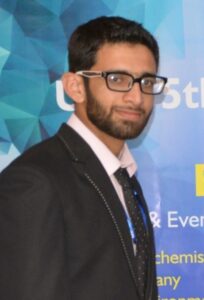
Ms. Naema Rani
Miss Naema Rani is young energetic researcher and recently she is doing her research work of MPhil in condensed matter physics, department of Physics, University of Gujrat. Her area of interest covers the most emerging field ‘Spintronics’ since a seminar has been conducted on the same field by the Chair of Department in University of Gujrat. Recently she is doing research for TM: SiC to be used in Spintronics devices. She did her BS from same department and her research work was on DFT study of electronic properties of LiCePO4 as a cathode material for upgradation of lithium ion batteries. During this work she review a paper on ‘A review on first principles-based studies for improvement of cathode material of lithium ion batteries. Nevertheless, she is young and very new in the field of Spintronics, she is paying her worth role to investigate new materials to be used in the emergent technology.

Ms. Khadija tul Kubra
Miss Khadija Tul kubra is young energetic researcher and recently she is doing her research work of MPhil in condensed matter physics, department of Physics, University of Gujrat. Her area of interest covers the most emerging field ‘Modification of Counter Electrode in DSSC’ since a project has been taken on the same field by the Chair of Department in University of Gujrat from HEC. Recently she is doing research for TM: SiC to be used in Modification of Counter Electrode and studying the adsorption and charge transfer phenomena. She did her BS from same department. However, she is young and very new in the field, she is paying her worth role to investigate new materials to be used in the emergent technology.

Ms. Marium Munir
Miss Maryium Munir is a young, new research student of MPhil in condensed matter physics, department of Physics, University of Gujrat. Her area of interest is on theoretical studies of ‘Nano materials’. Recently she is doing research for TM doped: TiO2 Quantum Dots to explore the electronic structural properties for use in different applications. She did her BS from same department in a same university. Nevertheless, she is young, active and very new in the field of ‘DFT’ she is paying her worth role to investigate new materials to be used in the emergent technology.

Ms. Afrinish Fatima
Miss Afrinish Fatima is a new researcher and recently she is doing her research work of MPhil in condensed matter physics, department of Physics, University of Gujrat. In research she is interested in ‘intercalation’ of lithium in LIBs because in batteries Lithium diffusion and intercalation is the basic part in working of batteries. So, she is doing her research in Lithium intercalated silicon carbide. She did her BS from same department in University of Gujrat. Also, she is writing a review on intercalation sites for lithium in LIBs. She is new researcher in this field and she is trying her best to play the rule for increasing the capacity of LIBs more than the graphite with creation of new material.

Ms. Salma Gulzar
Ms. Salma Gulzar is currently M Phil research student in the session of (2017-2019) in department of Physics, University of Gujrat, Pakistan. She did her BS Physics degree from the same university in the session of (2013-2017). Her area of interest was in Medical Physics and selected DNA as a material to study theoretically in research study. She is working on Physics of DNA under the supervision of Dr. Muhammad Isa Khan. The research topic assigned titled as “The Intercalation of Streptozotocin into DNA stakes as anticancer drug agent”. Cancer is a disease that is caused by the affected gene named as mutated sequence of base pairs in DNA strand. Intercalation is a process in which the guest structure fix itself into the host molecule without binding chemically. DNA is a double stranded genetic molecule that is considered as a unique structure in living beings that transfers genetic makeup and other attributes to the generations, and it can be explored with physics point of view also.

Mr. Shoaib Ahmad
Mr. Shoaib Ahmad is currently working as a MPhil research student session (2017 to 2019) in department of Physics, University of Gujrat, Pakistan. He is also interested in Medical physics for his M Phil research work, that’s why he is selected the proteins as a research material. His attempted to improve the performance of Proteins as well as enzymes thermostability and catalytic properties. Prior to this, he earned B.S. in Physics from Bahauddin Zakariya University, Multan.
He has been still working under supervision of Dr. Abdul Majid, Head of Department and Dr. Naeem Mahmood Ashraf, Department of Biochemistry and Biotechnology, University of Gujrat Pakistan.
His research interests include computational study of Bio-molecules with focus on thermos ability, catalytic properties, Mutation in proteins structures, industrial applications and also usage of Drug designing.

Mr. Naveed Ashraf
Mr. Naveed Ashraf is currently working as M.Phil. scholar in department of Physics, University of Gujrat, Pakistan. The area of his research is 2D materials and their engineering. He is focused to work on 2D materials including conductors, nonconductors and semiconductors as well. Now a day he is working on interfaces between highly innovative material Borophene and nonconductor boron nitride. He is working out to find the material and devices.
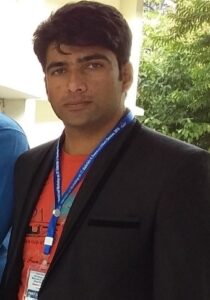
Mr. Wahid Ullah Khan
Dr. Abdul Majid, Chairperson Dept of Physics, UOG, is a passionate Researcher and Scientist in the field of Semiconductor Physics, his contributions to DFT-Analysis and cutting-edge research on materials has remained outstanding worldwide. During my masters I learned the fundamentals of Material Science and DFT under his kind supervision. journey didn’t end here, I am still the member of this esteemed group of DFT. I worked on semiconducting material and doping of different lanthanide series element in the slab of Titanium dioxide. And I got productive result when I analyzed with the existing former result in this regard.

Ms. Tanasum Shaheen
Miss Tanasam Shaheen is a young student of BS(hons), Semester 7th, from Department of physics, University of Gujrat, Pakistan. She is also working on “Exploring anomalies in interference pattern” as a research student in the department. Under the supervision of Dr. Abdul Majid, Head of Department, she is trying to explore Anomalies in interference pattern. Her research interests include dual nature of light and she is trying hard to give the true concept. She worked on various projects in the department such as windmill, Nuclear power plant (model), formation of alloys and designed thermostat for Lab. She worked on “Quantum tunneling” and trying to write a review paper on it. She won the prize in capturing the phenomenon where science and nature coincide.

Ms. Nigza
Miss Nigza is student of Physics department, University of Gujarat, Pakistan. Currently, she is working on “Plasmons in semiconductor nanowire” under supervision of Dr. Abdul Majid. Her research interest includes the interaction of light with nanostructures specifically, semiconductor nanowire. She wants to explore propagation of plasmons and characteristics of gallium nitride nanowire.
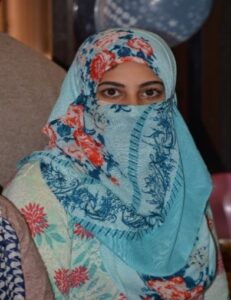
Mr. Muhammad Asim
Mr. Muhammad Asim is a young student of BS (hons) 8th-Semester from department of Physics, University of Gujrat, Pakistan. He has been keen to know the physics behind every phenomenon occurring in daily life. That’s why he chose physics as a subject for higher studies. He has been very interested in electronics and have designed many of the electronic circuits by his own in which the “Cost Effective Car Jammer” is at top of the list. During a class lecture on “Young’s double slit experiment” by Dr. Abdul Majid Sandhu (chairman physics department, UOG), he was much inspired about the nature of electromagnetic radiations. Then after, he started thinking over the nature of electromagnetic radiations and currently working over the observation of both particle and wave nature of electromagnetic radiations simultaneously under the supervision of Dr. Abdul Majid Sandhu.

Research Codes
- ADF (ADF, Band, DFT-B, REXFF) www.scm.com
- COMSOL COMSOL
- VASP VASP
Workshop As arranged by Material Science Group
Material Science Group in collaboration with Department of Physics, UOG arranged a workshop entitled as
“1st Two Day National Workshop on Material Modelling &Simulations”
from April 09-10, 2019. This workshop was directed and organised by the Chair, also the chairperson of Department of Physics, Dr. Abdul Majid and Dr. Muhammad Isa Khan. This workshop was basically a hands-on training to the ADF, ADF-BAND molecular suit. In this workshop, researchers across the Pakistan are encouraged to register online. The chair inaugurated this workshop by explaining the challenges to the countries and especially to the third world countries like Pakistan. Then Dr. Salman Tahir, Dean of Social sciences, welcome all the guest students and Faculty members, shed light on the problems to the Pakistan such as “terrorism ”, the duty of researchers in this situation and appreciate the chair for arranging such workshop.
The guest speaker, Dr. Shafqat Hussain Shah and Dr. Akhtar Hussain from PINSTECH talked about the basics of DFT, why DFT is necessary in this era and how DFT helps to resolve the present day problem.
After that, the Hands-on training on ADF was carried out by the Dr. Abdul Majid, while the trainer for ADF-BAND were Mr. Arslan Ullah and Mr. Azmat. All other group members were present to help out the guest researchers present in the workshop. For this purpose, proper tutorial were prepared, that were given to the guest researchers at the end for their help in future. In this workshop, along the computation, their utilization for specific applications were also explained.
At the end, the active Vice Chancellar, Dr. Faheem Malik joined the workshop, Congratulate the Chair for organizing such an event and present the Shields to the chair, Dr. Abdul Majid, Dr. Muhammad Isa Khan and all the guest speaker and certificates to the guest researchers and organizers. Some pictorial Glimpse are given in Photo Gallery.
Featured Research work by the Current Researchers of Group
A Density Functional Theory study ofTm doped layered Silicon Carbide for application in spintronics
By Ms. Naema Rani
In condensed matter physics, the study of magnetic and semiconducting materials is getting considerable attention. Among these semiconductors, the Spintronics is one of the challenging and fascinating branches in which half metallic semiconductors reveal applications in data storage and data processing which paved path for commercial uses. ADF-BAND code in the framework of first principles-based studies is used to investigate the applications of TM doped SiC in Spintronics. The structural, electronic and magnetic properties of Ti, V, Cr, Mn and Fe doped SiC are studied in terms of ferromagnetic (FM) and antiferromagnetic (AFM) configurations. These dopants reveal states that lie within the band gap and these states are considered valuable for the study in Spintronic applications. GGA-PBE functional along DZP basis set is used to incorporate long range as well short-range interactions. Our results reveal that among all studied, Ti reveal non-magnetic properties whereas Mn as well Cr doped SiC exhibits FM and remaining V and Fe doped SiC showed AFM as stable configurations. Moreover, the magnetic moments of 0 μB, 1.24 μB, 2.37 μB, 3.01 μB, and 2.21 μB of Ti, V, Cr, Mn and Fe respectively in the stable configuration is observed. Meanwhile, the super-exchange, RKKR method and double exchange interaction mechanism is observed for different dopants and their detailed discussion is done. The dopants reveal 3d-2p hybridization interactions and models based on charge hopping, AFM based super-exchange interaction as well as FM based super-exchange and double exchange interactions are discussed in detail. While the ordering temperatures in terms of Curie/ Neel temperatures are also determined and the material with half metallic character is considered as potent for use in applications of Spintronics. Intercalation is a surprising phenomenon in batteries without that a battery cannot work. In this there are two basic parts for intercalation ‘guest and host’. In LIBs the guest is always the lithium, but the host material is a variable that can changed. In Intercalation the guest material is inserted in the host material that modifies that host material to play their rule in batteries. Intercalation requires enough space in host structure so the lithium atom would not face the difficulty in SiC(host). The host structure can have different sites for intercalation but for this purpose remember that lithium cannot be inserted on vacancy sites so there must be interstitial sites for lithium intercalation. There are normally more than one interstitial site available in the structure that can be checked one by one to find the most stable site for lithium with minimum energy. Only the most suitable site for lithium is selected in order to increase the lithium concentration. After intercalation there is the need to know the stability of lithium in host so the lithiation energy can help this to find the stability. The more negative the lithiation energy, the more favorable lithium configuration would be finalized. Importantly, for intercalation purpose layered structure of host would be beneficial because in layers the interlayer distance plays an important rule for lithium insertion. If the host structure is not a layered material, then obviously the lithium will be disturbed in the material. The staging phenomenon is an important part of intercalation for checking the stability of lithium in more than one layers of host structure. The staging is needed because experimentally it may be not possible for lithium to place in every layer so there is the need to check the most favorable lithium insertion in layers. The number of layers of host between the lithium layers defines the number of staging.
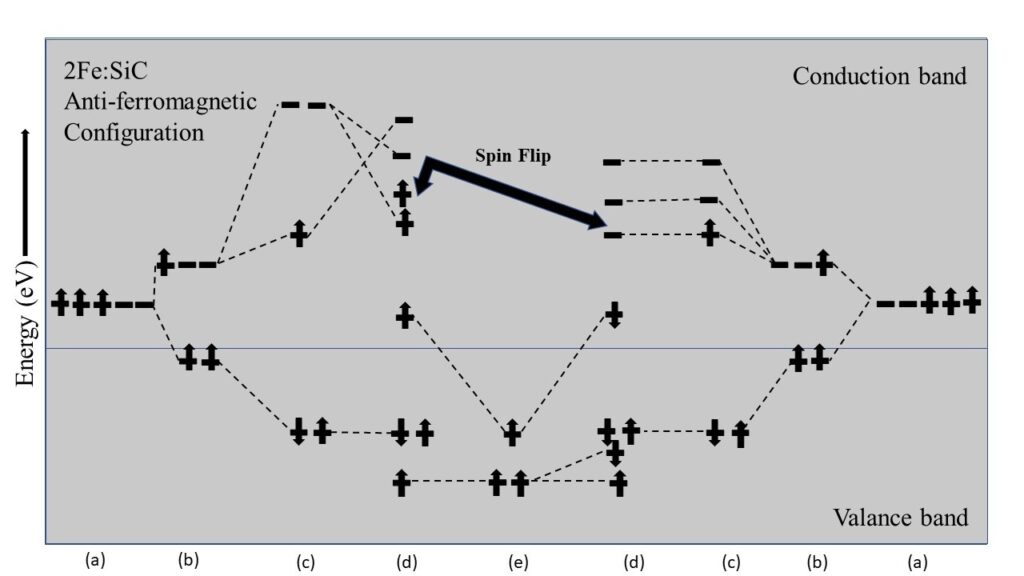
Computational study of transition metals doped Silicon Carbide slabs for the application as counter electrode in Dye Sensitized Solar Cells (DSSC)
By Ms. Khadija-tul-Kubra
Counter Electrode is an important component of Dye Sensitized Solar Cell (DSSC) whose catalytic activity strongly influences efficiency of the cell. In this work, a comprehensive computational study was carried out to explore new materials obtained after doping of transition metals into silicon carbide (SiC) to improve the functioning of DSSC. The slab model SiC after doing with several 3d and 4d transition metals (Ti, V, Cr, Fe, Mn, Zr, Tc, Nb, Mo, Ru, Pt) was studied to investigate the structural, electronic properties and catalytic activity of the material. To study amount of charge exchanged between the slab and electrolyte, the tri-iodide and mono- iodide were adsorbed on the slab and the adsorption energy values for found to explore the iodine reduction reaction (IRR). The adsorption of mono iodide can be used alternately to calculate the charge transfer and adsorption energy. It was found material remained semiconductor after doping and adsorption. To find the favorable site of adsorption the energy profiling was carried out by placing the mono-iodide at different possible sites on the slabs. The thorough analysis of energies, charge transfer and Density of States suggested that Zr, Nb, Mn, Mo doped SiC slabs exhibited improved catalytic activity than that of Pt doped SiC based counter electrodes. The findings of this study predicted new materials which can substitute Pt and relevant materials for use as counter electrodes in DSSC.
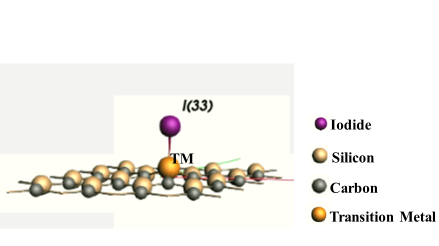
How does the adsorption studied help to explore the flat atomic world?
By Ms. Afrinish Fatima
Adsorption is the adhesion of atoms, ions or molecules from a gas, liquid or dissolved solid to a surface. This process creates a film of the adsorbate on the surface of the adsorbent. Adsorption is present in many natural, physical, biological and chemical systems and is widely used in industrial applications such as heterogeneous catalysts. The basic purpose of adsorption is to find the most suitable site on the structure for adsorbent. For example, a structure of 54 atoms then it is very difficult to decide what is the most favorable for atom and site of atom for the theoretical study because when atom will adsorb on suitable site the transfer of electrons will be maximum which is big edge for many energy storage devices. For this purpose, adsorption energy is calculated and at which atom adsorption energy is minimum at that atom adsorbent atom will stick and will stable. To check the phenomena of adsorption more clearly compare the electronic properties of structure before and after adsorption. For example, in Co3O4 the most suitable site for adsorption of Hg0 is (1 1 0). At this site the adsorption energy (Eads) is −74.037 kJ/mol and at this energy the electron transfer rate is maximum so this site is considered as most favorable for Hg0 on the structure of Co3O4.
Similarly, atoms of Nitrogen and Sulfur have been adsorbed on flat and steep surface of Gold. The most favorable sites of Gold are (111) and (211) for Nitrogen and Sulfur. From all the theoretical investigation it is observed that adsorption has significant worth because the rate of electron transfer depends upon it. So, it is noted that in flat atomic world by adsorption study we can find the most stable atom in the structure and by adsorption energy rate of charge transfer can be estimated. Potential energy Surface scan (PES) technique can be used to check the most favorable atom and its site. Adsorption study plays an important role in Dye sensitized solar cells (DSSC). In the modification of Counter electrode which is main component of DSSC have the effect of adsorption. Any transition metal is doped in Semiconductor material and any Electrolyte mostly tri-iodide or iodide is adsorbed on the structure. Iodide will adsorb on most suitable atom and then adsorption energy is finding as well as charge transfer rate.
Size dependent electronic structure of TiO2 quantum dots.
By Ms. Marium Munir
The past couple of decades have witnessed an exponential growth of activities in the studies of semiconductor quantum dots due to their exciting size, shape- and composition dependent properties. Titanium dioxide (TiO2) is an important semiconductor that has widespread application because of its low cost, stability and environmental compatibility. Moreover, titanium dioxide has also been found to exhibit unique characteristics suitable for gas sensing, solar cells, water photolysis and photo catalytic decomposition of organic and inorganic pollutants. Photo catalysis makes use of the semiconducting properties of TiO2 having an inherent band gap of 3.0 eV for rutile and 3.20 eV for anatase structure. Recently, the research activities on TiO2 received much attention because of its use in the dye-sensitized solar cells. For these exciting applications, it become necessary not only to synthesize such solid state and molecular systems but also to reliably model their properties that varies with size. As the size of the material decreases, the quantum confinement effect and surface states become important and the properties become size-dependent. The small size and large diversity in shapes of nanostructures are particularly attractive for exploring many unique and novel properties. The photocatalytic activity of TiO2 depends sensitively on the size and shape of the nanoparticles. There are many experimental studies devoted to the size-dependent photocatalytic activities of TiO2 nanoparticles. However, extensive theoretical investigation, in particular, the evolution of electronic structure as a function of size of the Nano- crystal are of crucial importance because it allows one, on the one hand, to investigate fundamental physics and, on the other hand, to optimize nanostructure devices. In the literature, there exist theoretical studies on small TiO2 clusters.
A multipurpose material, Titanium dioxide (TiO2) has been extensively studied for its technological applications which include photocatalytic activities and DSSC’s. In this work, detailed first principles-based calculations were carried out to design TiO2 quantum dots in order to enhance the photo-catalytic activity for application in Dye-sensitized Solar cells (DSSC’s). The structural, optical and electronic properties different sized pure as well as doped TiO2 quantum dots were calculated by applying DFT and DFTB methods. The self-consistent charge density functional tight binding theory (SCC-DFTB) was used to model the TiO2 Quantum dots of increasing realistic size up to 3.0 nm which can be used in practical applications. The QD Ti27O54 was doped with 3d transition metals to further explore the possibility of tailoring the properties.
The findings are helpful to enhance the photo-current efficiency of Dye-Sensitized Solar Cells and use the materials in electronic and optoelectronic properties.
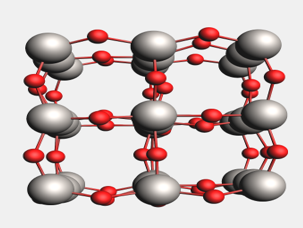
Physics of DNA
By Ms. Salma Gulzar
This time was the start of my research work. I selected DNA molecule to study its physical Properties while the process of mutation. These mutations in gene sequences cause cancer or tumors in different organs of living organisms. The mutated regions replicate that way that they form uncontrolled growth of those cells and the process of cell death get irregular to the normal ones. During the last few decades with the development of medical research sciences, the complete treatment of cancer is become possible with surgery, hormonal therapy, combination therapy, radiotherapy and chemotherapy. Chemotherapists are working over the area of drug resistance to enhance this treatment method. The drug agents that are used in tumor treatment are structurally organic with an alkaline moiety. In treatment mostly Aromatic compounds and their derivatives are used. They say that the treatment of many of the tumors is possible with a single agent but probabilities of side effects also. I reviewed the literature in early period of selection of drug agent for my specific drug. Ethedium Bromide was the most common intercalating agent used. There were so many of the drug agents such as Doxorubicin, Adriamycin, Streptozotocin, Berberine, Quinacrine, Elipticine, Thalidomide and Procarbazine etc. Streptozotocin selected because of the novelity purposes of research studies. Streptozotocin is a scientific name of Zanocar used commonly for the treatment of cancer of pancreatic beta cells because of the toxic nature for proper functioning of blood glucose level. At the start of theoretical study of DNA intercalation, I had to optimize my primary structure to do further calculations. It was a complicated structure with no proper symmetry to deal with. B3LYP hybrid functional is reported as compatible to Organic structures but in ADF-Molecule it took so long to get converged geometry because of its heavy computational cost. So I took the base pairs stack without the phosphate backbone as a host material to the drug intercalation agent. The equilibrium geometry was attained with GGA-PB86 functional. DNA plays a crucial role in all living organisms because it is the key molecule responsible for storage, duplication, and realization of genetic information. The most significant sections are genes, parts of DNA, which carry information about the sequence of amino acids in proteins. The importance of the DNA molecule cannot be overestimated. It is therefore natural that the molecule has been attracting attention not only of biologists and physicians but also of chemists and physicists, even theorists. Structure of materials is mostly studied with x-rays on the basis of Bragg’s Law. For DNA structure identification, Francis Crick and James Watson used x-ray diffraction. DNA exposed as a three-dimensional structure with sequences base pairs. Physical structure of DNA is reported as a heteropolymeric molecule that is consisted of 4 base pairs. The boding is specific with each other as A=T and C⁝G, faulty base pairing also leads to mutations. The structural properties of DNA is interesting for all fields of sciences. We can’t say DNA is completely biological because of its genetic properties but its base sequenced pairing and spiral double helix structure also makes it relevant to Physics.
The double helix has a diameter of 2 nm, so it is not surprising that DNA is of considerable interest to researchers in nanotechnology. The fact that adenine always binds with thymine, and cytosine with guanine, also gives DNA built-in “intelligence” when used as an engineering material. As Andrew Turber field explains in DNA as an engineering material, DNA has already been used as a molecular glue and as fuel for molecule tweezers. Moreover, a “DNA computer” recently solved what is probably the largest mathematical problem ever tackled using non-electronics means. Other physicists have explored the electronic properties of DNA and its use as a scaffold for solid-state dye lasers. DNA might even be a superconductor. There are sure to be more twists and turns in the physics of DNA.
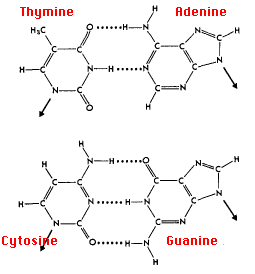
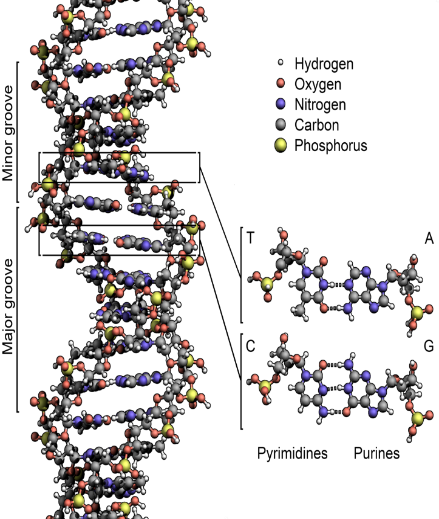
Potentials of interfaces for applications
By Mr. Naveed Ashraf
This phase of my research carrier is very exciting in which I turned towards energy devices which are real hopes for the future of humankind. I have chosen to work on energy storage 2D materials especially materials involved in lithium ion battery. The literature review motivated me to investigate borophene as good choice to work with as Li ion battery anode material. I faced problems to optimize its structure and understood its complex structure. In addition to study the electronic properties of the anode material, I am employing ADF: BAND simulations to optimize the structures. Basically, borophene is 2D material having high charge storage capacity but at high temperature 2D materials are unstable due to thermal fluctuation .to solve this I have engineered the 2D material and make interface with high stable 2D material boron nitride. I remove the lattice mismatch by choosing their suitable periodicity i have optimize the supercell of borophene and boron nitride. After optimization the both structure I interface the borophene with boron nitride and optimize it. I will check their thermal stability at different temperature by using ab initio molecular dynamics (AIMD). after intercalation the lithium ion in the interfacial structure I will check the power density of the structure. In addition to this, I will employ Nudged Elastic Band Method to find the hooping barrier and diffusivity for the desired electrode material. After using several tools to theoretically investigate the properties of materials, I came to know that interface enhance the material property for example hexagonal boron nitride which is used as interfacial layer in the anode metals to suppress the dendrite growth. Before interface of 2D materials the main issue is to solve the problem of lattice match. The lattice mismatch can be minimizing by considering the surface periodicity of the two materials. Binding energy between the two materials which are used for interface tells about the structural stability of the interfacial structure. The thermal stability calculated of the interfacial structure calculated by using the tool of AIMD tells about the existence of material at maximum temperature. Mechanical stiffness of the material indicates the hardness of interfacial material. Band gap of the interfacial tells about the electronic property of the material and their suitable application for electronic applications. My research work on interface is continue I will further explain it at the end of this task.
Proteins or Enzymes
By Mr. Shoaib Ahmad
This phase of my research carrier is very exciting in which I turned towards highly stable proteins or enzymes which are real hopes for the future of humankind. I have chosen to work on serine protease bio-molecule especially this material involved in industrial level. The literature review motivated me to investigate Serine protease as good choice to work with as catalyst material. I faced problems to optimize its structure and understood its complex structure. In addition to study of the structure stability-activity relationship of serine protease but also highlights, that modification of non-catalytic residues could also promote favorable catalytic behavior. I employed Molecular dynamics simulations to improve the thermostability for the mutants. In addition to this, I utilized Constraint Network Analysis, Nano-Scale molecular dynamic Simulation computer software’s to find the proteins thermostability and thermal un-folding. The 3-D structure of serine protease contained 446 amino-acids is sketched in figure. After using several techniques and tools to theoretically investigate the proteins thermal un-folding, thermostability and catalytic properties of bio-molecules, I came to know that protein engineering in which two main techniques is highly resourceful techniques to study the physics and chemistry of proteins it helps to calculate the rate of reactions, energy factors, catalytic activity and thermo-stability etc. The application of Rational Design technique helps studying the proteins energy factors, isolation and characterization of serine protease from Pseudomonas aeruginosa in very simple and efficient way. This is advance form of basic characterization, the protein is engineered by site-directed mutagenesis of selected non-catalytic residues, to increase its thermal stability and catalytic activity.
Physics and the life sciences have established new connections within the past few decades, resulting in biological physics as an established subfield with strong groups working in many physics departments. These interactions between physics and biology form a two-way street with physics providing new tools and concepts for understanding life, while biological systems can yield new insights into the physics of complex systems. A main theme is the realization that biological systems, in particular proteins, do not exist in unique conformations but can assume a very large number of slightly different structures. This complexity is captured in the concept of a free energy landscape and leads to the conclusion that fluctuations are crucial for the functioning of biological systems.
Proteins are molecular machines, building blocks, and arms of a living cell. Enormous variety of protein functions is based on their high specificity for the treated molecules that resembles the key and-lock relationship. It is worth mentioning that the kinetic investigation of protein folding was conventionally held under or extrapolated to biological conditions (25–37 ◦C, neutral pH, absence of denaturant). In addition to the biological relevance of these conditions, the folding intermediates are most readily accumulated and investigated when the folding takes place here, where the native state together with the folding intermediates is much more stable than the unfolded state. It is noteworthy however, that folding can occur also in the zone of thermodynamic equilibrium, where the unfolded state is as or almost as stable as the native state of the protein, while all the intermediates are unstable and thus cannot be accumulated in principle by the definition of the all-or-none transition, which has been observed in thermodynamics. Physical investigation of protein folding started more than half a century ago. Physics of large multi-domain proteins and protein complexes is far from maturity, though; but one may believe that its future development will be based on physics of single-domain proteins, like the development of chemistry is based on physics of atoms and electrons. In short is highly useful for the emerging field.
Illustration of dual nature of light
By Mr. Muhammad Asim
My research phase is very interesting and helpful for me. In the very beginning, I started with the dual nature of light. Since dual nature of light is very exciting and more interesting phenomenon of physics, I worked to observe both these natures at the same time. I started from an experimental setup designed on COMSOL but unfortunately, didn’t get my goal. But, it was very informative for me and my fellows and we learned a lot. Then I moved to double slit interference experiment.
After studying about electromagnetic waves thoroughly, we come to know that in some case, light is particle and wave in others. In classical cases, it is purely a wave. But Quantum mechanics take it as both. This is really exciting and attractive phenomenon that how can it change its behavior. It is interesting for me and became my research area. Then, I started by using COMSOL. I designed double slit experiment on COMSOL using RF module with in 2D geometry. I obtained interference pattern with 3.75m wavelength. The interference pattern has central maximum (bright fringe) and two bright and dark fringes. But still I’m working on this experimental setup to get clear literature like patterns. Actually, I want to observe the anomalies in interference pattern when light source is used at different angles. Working with the theory that light has two parts; particle part and a wave part, at the same time, I’m going to observe anomalies. If light is a wave with no particle part, then there must be no change in interference pattern for light source at different angles. If the two light sources are coherent and now their angle is change, interference pattern may change. So, we can say that when angle is changed for slits, sometimes the wave part interacted with particle part and vice versa, interference pattern changes. It is very interesting effort because with this theory many problems be solved and we can say that in the same problem, light has two parts. Also, this theory will help many researchers in the future to explore exciting facts about light. The nature of electromagnetic radiations is not certain. We know the electromagnetic radiations have dual nature, which means that these radiations may behave as a continuous wave in one experiment and as a stream of particles in another experiment under same conditions. Up till now, all experiments showed that electromagnetic radiations are either waves or a stream of particles but never both simultaneously. But this concept eventually fails when one observes the spectral anomalies in the interference pattern of electromagnetic radiations obtained from Young’s double slits experiment. These anomalies in the interference pattern show that these radiations are not behaving purely as waves in this experiment and ultimately the incomplete understanding about the nature of electromagnetic radiations. The interference blots have been recorded in the interference pattern of electromagnetic radiations, which show that electromagnetic radiations do not behave purely as wave when they interfere. Different anomalies have been recorded in the electromagnetic radiations. Jixiong Pu. et al. reported that the anomalies of electromagnetic radiations can be observed in interference field (both near and far field) by illuminating the slits of Young’s double slits experiment with both completely and partially coherent polychromatic light. The anomalies can be seen as red-shift and blue-shift in the interference field. They reported that these anomalies can propagate in free space and can be used for communication purposes. Ibison et al. reported that the anomalies in the interference pattern influenced by the intension of operator performing the experiment. They conducted the two experiments at different places under same conditions, but the interference patterns were seemed to be different from each oth
Theoretical study of shape dependent optical properties of Gold Nanostructures
By Ms. Tanasum Shaheen
My research work, conducted by simulation package COMSOL Multiphysics, support the interaction between light and matter. Five distinct shaped Gold Nanostructure of equal size; 100 nm, are irradiated by electromagnetic waves in the visible region of electromagnetic spectrum, from 400 nm to 700 nm, and their optical properties have been studied. The properties include Skin depth, Refraction index, Relative permittivity, Absorption cross section and Extinction Cross section. Results indicate that all the properties vary with the shape of nano-structure, throughout the calculated range of wavelength. Skin depth and Refractive index of gold are highly related with each other. Moreover, inverse relation exist between refractive index and relative permittivity. Nanostructures with sharp appex exhibit more skin depth and smooth surface nano-structure have low refractive index. Surface Plasmon Resonance for all shapes is obtained at 540 nm. Thus optical properties are highly shape dependent for Gold nanostructure. The results obtained for Skin depth, Refractive index, Relative permittivity, Absorption Cross Section and Extinction Cross Section have shown in (a), (b), (c), (d) and (e) respectively.
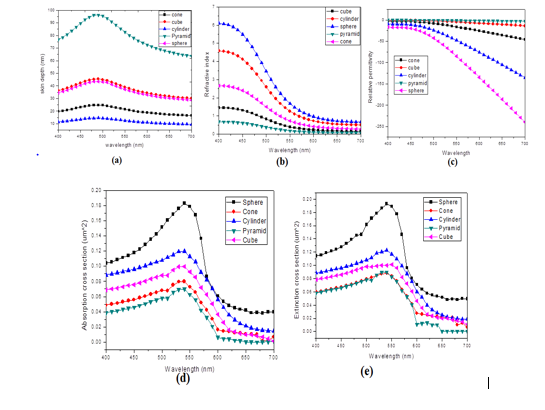
A theoretical study of plasmons in Gallium Nitride Nanowires
By Ms. Nigza
Semiconductors nanowires play an important role in electronic and optoelectronic devices at nanoscale. These increases efficiency of devices by consuming less material and provide greater energy. III-V semiconductor, Gallium nitride nanowire used as basis for designing photo devices. Gallium nitride have wide band gap due to which it can be used at high temperature. It has two crystalline structure zinc blende and wurtzite. Wurtzite structure is used in this work that has more energy than zinc blende structure but energy of both structure is too close. Electromagnetic waves when falls on semiconductors nanowire plasmons i-e collective oscillations of electrons, are formed at interface. Their study in nanowires provide a new research area. The use of plasmons in electronic and optoelectronic devices is important because electromagnetic energy is strictly confined when it is present in from of surface plasmons. The coupling of plasmons is also investigated in semiconductor nanowires. It found that coupling means interaction between plasmons increases the electromagnetic field and also have larger propagation length. Hence, coupling effect is employing to increase the efficiency of nanodevices. Effect of coupling and increment in number of Gallium nitride nanowires on flux density of plasmons is also investigated.
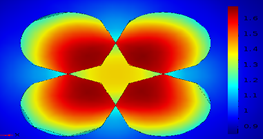
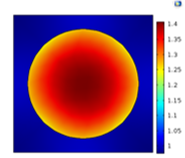
Future Research Directions
- Lithium ion Batteries
- Solar cells
- DSSC
- Organic and inorganic dyes
- Topological Insulator
- 2D layer
- Medical Physics
- Computational study of DNA, Enzymes, Proteins
List of Publications
- Structural and Uniaxial Magnetic Anisotropy of Co1-XMgX (X = 0.04–0.12) Nanowires in Alumina Templates , Naeem Ahmad, Abdul Majid, Saira Parveen, Wiqar Hussain Shah, Faryal Mughal, Suleman Khan, Imran Murtaza, Journal of Superconductivity and Novel Magnetism In-press (2019)
- Dominance of Shape Anisotropy among Magnetostatic Interaction and Magnetocrystalline Anisotropy in Electrodeposited (FeCo)1−xCux (X = 0.1–0.5) Ternary Alloy Nanowires, Naeem Ahmad, M. Zahid Shafiq, Suleman Khan, Wiqar Hussain Shah, Imran Murtaza, Abdul Majid, Khalid Javed, Journal of Superconductivity and Novel Magnetism In-press (2019)
- First principles study of transition metals doped SiC for application as counter electrode in DSSC Abdul Majid, Irslan Ullah, Khadija Tul Kubra, Salah Ud-Din Khan, Sajjad Haider, Surface Science 687 (2019) 41–47
- First principles investigations of vibrational properties of titania and zirconia clusters , Abdul Majid, Alia Jabeen, Khan, S. U. D., & Haider Journal of Nanoparticle Research, 21(1), 20 (2019).
- First Principles Study of Dendritic Carbazole Photosensitizer Dyes Modified with Different Conjugation Structures, Abdul Majid, Maryam Bibi, Salah-Ud-Din Khan, Sajjad Haider, Chemistry Select, 4, 1-9 (2019) DOI: 10.1002/slct.201803575
- A review on transition metal doped silicon carbide , Abdul Majid, Naema Rani, Muhammad Faheem Malik, Naeem Ahmad, Najam-al-Hassan, Fayyaz Hussain, Abdul Shakoor Ceramics International, 45 8069–8080 (2019)
- Effects of thermal annealing on structural and magnetic properties of Mn ions implanted AlInN/GaN films , Abdul Majid, Salah Ud-Din Khan, Sajjad Haider, J.J. Zhu, Journal of Magnetism and Magnetic Materials, 469, 618-622 (2019)
- First–principles of vibrational properties of TiSiO4 clusters, Abdul Majid, Amber Batool, Salah Ud-Din Khan, Sajjad Haider, International Journal of Quantum Chemistry 119(14):e25924 (2019)
- Optical Properties of Titania–Zirconia Clusters: a TD-DFT Study , Abdul Majid, Alia Jabeen, Salah Ud-Din Khan, Sajjad Haider, Journal of Cluster Science 30, 707–713 (2019)
- Voltage dependent physical, dielectric and magnetic properties of electrodeposited Co1−xMnx alloy nanowires , Muhammad Awais, Naeem Ahmad, Suleman Khan, Affan Safeer, Khalid Javed, Imran Murtaza, Abdul Majid Journal of Magnetism and Magnetic Materials, 474, 207-214 (2019)
- Tailoring magnetic characteristics of phosphorene by the doping of Ce and Ti: A DFT study , Fayyaz Hussain, Muhammad Imran, Anwar Manzoor Rana, Muhammad Ismail, R.M. Arif Khalil, M. Atif Sattar, M. Arshad Javid, Abdul Majid, Yongqing Cai Physica E: Low-dimensional Systems and Nanostructures 106, 352-356 (2019)
- Enhanced photocatalytic hydrogen energy production of g‐C3N4‐WO3 composites under visible light irradiation , M.B. Tahir, M. Rafique, M. Isa Khan, A. Majid, F. Nazar, M. Sagir, S.Gilani, M. Farooq, A. Ahmed International Journal of Energy Research 42, 4667-4673 (2019)
- Structural and Electronic Properties of PPy-DBSA/Zirconium Oxide Composites , Muhammad Irfan, Abdul Shakoor, Abdul Majid, Najamal Hassam, and Niaz Ahmed, Polymer Science, Series A, 61 105–111 (2019)
- Laser Surface Hardening of Gun Metal Alloys , Samia Naeem, Tahir Mehmood, K. M. Wu, Babar Shahzad Khan, Abdul Majid, Khurrum Siraj, Aiman Mukhtar, Adnan Saeed and Saira Riaz, Materials 2019, 12, 2632
- Study of Structural, Thermal and Dielectric Modulus of PPy–DBSA–Zirconium Oxide Composites M. Irfan, A. Shakoor, A. Majid, N. Hassam, and Niaz Ahmed, Russian Journal of Physical Chemistry B, 2019, Vol. 13, No. 6, pp. 1057–1063.
